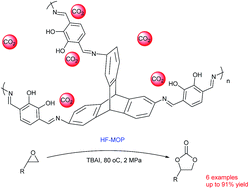A hydroxyl-functionalized microporous organic polymer for capture and catalytic conversion of CO2†
Abstract
A novel hydroxyl-functionalized microporous organic polymer (HF-MOP) was designed and synthesized through simple polycondensation reaction of 2,3-dihydroxyterephthalaldehyde and 2,6,14-triaminotriptycene. The polymer exhibited good CO2 capture performance (8.7 wt%, 273 K and 1 bar), and simultaneously functioned as a metal-free heterogeneous catalyst for the cycloaddition of CO2 with a series of epoxides to cyclic carbonates (82–91%) under mild and solvent-free conditions. Moreover, HF-MOP can be recycled five times without a significant decrease in catalytic activity.


 Please wait while we load your content...
Please wait while we load your content...